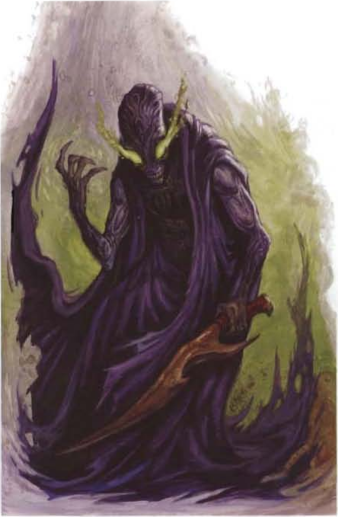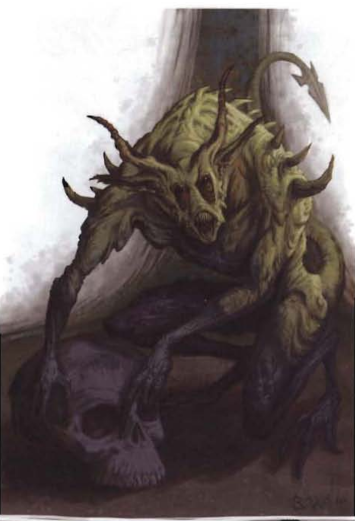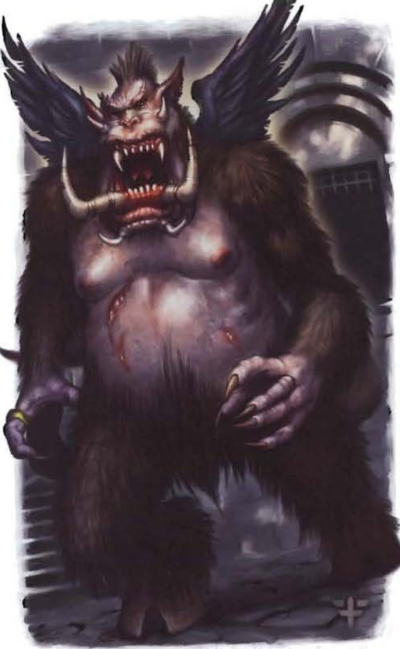Posts
-
Let's Read the 4e Monster Manual 3: Demon, Ultrodemon

Copyright 2010 Wizards of the Coast This post is part of a series! Click here to see the others.
This creature first appeared as an “Ultrodaemon” in AD&D, as part of the effort to give every alignment its own brand of outsider. In 4e, daemons lost an “a” and became demons. We already saw some of them in the readings of earlier books.
The Lore
Ultrodemons are somewhat atypical among demons because they’re more about greed than about cruelty for cruelty’s sake. They enjoy carnage and torture as much as the next demon, but their real passion is material wealth. They command armies of mezzodemons and nycademons, sell their mercenary services for ruinous prices, and loot as much as they can during these operations.
Ultrodemons and their underlings can be found in a wide variety of places, either under contract to some other villain, or working independently. They’re very rarely loyal to their employers, though, and will turn on them as soon it looks more profitable than fulfilling the contract.
The Numbers
This entry only has a single stat block, for an Ultrodemon Schemer. This is a manipulative villain who will likely only fight the PCs in a battlefield of its own choosing and backed up by a large number of demon allies.
It’s a Medium Elemental Humanoid with the Demon tag, and a Level 22 Controller (Leader) with 205 HP. It has a ground speed of 7 with Phasing, which allows it to walk through walls. It also has Blindsight with range 5.
The schemer wields a longsword whose attacks deal physical damage and daze for a turn on a hit. It can also use magic to shoot Fiery Rays that deal fire damage. Its command ability is represented by the Demonic Authority power, which allows each ally adjacent to the schemer to make a melee basic attack with combat advantage as a free action. This recharges when the demon is first bloodied.
To complement its sword, combat magic, and command ability, the schemer also has a few nasty mind tricks it can use as minor actions. The first is Hypnotic Gaze (recharge 4+) immobilizes on a hit, and has an effect that prohibits the target from attacking the schemer for a turn. “Effects” in 4e parlance are things that happen even on a miss.
The other trick is Treacherous Gaze (recharge 6+), which dominates for a turn.
As its triggered actions, the schemer has a middling version of Variable Resistance, which gives Resistance 20 but only works once per encounter. It also has Self-Preservation, which triggers when an enemy bloodies it. It causes the schemer to teleport and swap places with an ally within 10 squares, and gives the ally a chance to make a free basic attack against the triggering enemy.
All of this points to a demon who wants to be close to Team Monster’s skirmishers and assassins, and who will accompany them to try to get around the party’s front line. It things become too hot, it will bring in a soldier or brute from its own front line to spice things up while it flees to safety.
Final Impressions
I remain a big fan of folding daemons into demons! Mechanically, ultros work well as “sneaky leaders”, which isn’t a combination you see very often.
-
Star Wars RPGs and The Force: A Thought

Image source. This isn’t part of a series or anything, but it’s a random though I’ve been having and I feel it’s worth turning into a post.
The Thought
If I ever to a Star Wars adaptation, it’s going to be one where everybody is Force-sensitive. Let’s do away with the absolutist “magic/no-magic” divide inspired by D&D that all the official RPGs so far have used. If the Force is described in the source material as being in everyone, then it should be in in everyone.
Players would not be forced to play Jedi - rather, the badassitude of their PCs would be explained by their connection to the Force. No more of that nonsense about how “you can still be cool even though you’re blind to the Force”. No, you’re cool because you opened yourself to it. It’s everywhere, and getting past a certain threshold of skill at any endeavor means becoming attuned to the Force. By definition, any character who is PC material in the sort of heroic story Star Wars favors is past that threshold.
Like, yeah, you can still be a Jedi who throws stuff around telekinetically and parries blaster bolts with a lightsaber, but you can also be an amazing gunfighter from the slums of Coruscant who can dodge blasters, react to stuff before it happens, and make shots that ricochet from five different surfaces before hitting some impossibly small target. And maybe both of you can jump really high because that’s always useful.
There’s a set of Force-based mechanics that all PCs gets access to, even if they have the least mystical background possible. They can use it to perform impossible feats of skill and luck. They can have intuitions and premonitions. Maybe they can study a mystical tradition to do more overtly supernatural stuff, but that’s not required.
And maybe one of the reasons the Dark Side and the Empire are evil is that they’re the ones who believe that only a select few elites should be given access to the Force.
-
Let's Read the 4e Monster Manual 3: Demon, Quasit

Copyright 2010 Wizards of the Coast This post is part of a series! Click here to see the others.
I believe quasits have been around since AD&D 1st Edition, and they’ve re-appeared in every edition since. This is where they enter 4e.
The Lore
Back when they first appeared, quasits were simply the demon equivalent of Imps: tiny, winged, and tricksy. The only reason they were a different creature at all is was because of the game’s insistence that demons and devils are completely different creature types.
In Dungeons & Dragons Fourth Edition, quasits are… the demon equivalent of Imps. Still tiny, still tricksy, they’re extremely easy to summon as familiars and live to tempt their masters into committing ever more horrible acts of destruction. When one of these masters die, the quasit captures their soul and takes it to its true master, usually a demon lord. Demons don’t need souls, but I guess they’re tasty.
Quasits are usually encountered with whatever dupes they’ve managed to tempt this time or with other, bigger, demons. Minions might include people of any sapient species, with or without a spellcaster. They also like arcanians. Quasits tend to remain invisible for as long as possible and let the others do most of the work for them.
The Numbers
Quasits are Tiny Elemental Humanoids with the Demon tag. They’re a bit stronger than imps by default, being Level 7 Controllers with 75 HP. They have darkvision and a fantastic ground speed of 8, though they’re not winged and can’t fly in this edition.
They’re unusual among demons in that most of their attacks have a trickery and temptation theme, to an even greater extend than an imp. This starts with their Tempter’s Influence aura (2), which inflicts a -2 penalty to saves on enemies caught inside. They can also become Invisible at will with a minor action (1/round), and stay in this state until they make an attack roll.
Their basic attack is a Reach 0 venomous bite, which does physical damage and forces the target to grant combat advantage (save ends). Reach 0 means they need to enter the target’s square, which they can do because they’re Tiny.
Their other attack is Evil Temptation, a mind-affecting spell that targets Will and affects enemies in a Close Blast 3. This is another at-will minor action (1/round), and though it does no damage it dazes (save ends). The “temptation” here is that victims can choose to end the effect early by making an attack against one of their allies!
Final Impressions
So I guess quasits aren’t just demonic imps in 4e. They’re also doing some of the succubus’ job now that she left to become a devil. PCs affected by Evil Temptation are likely to try to shrug it off with saves at first, but if they have a streak of unlucky rolls that friendly fire incident is going to start feeling mighty attractive. Daze is such a serious condition after all…
It’s a genuine temptation mechanic! I think I only saw one other instance of this, for the MM2’s Misfortune Devils. Not even succubi themselves have temptation mechanics, since their powers and “lore baggage” end up making them better for making PCs run away. This is an at-will Blast attack, so you’ll likely have multiple PCs affected by the power at any one time.
Quasits should fight by alternating Evil Temptation and Invisibility, and should hang around close to “tempted” PCs while invisible to make their saves harder. While this is happening, the quasit’s larger allies are going to have a field day with all those dazed heroes. Brutes and artillery work well here.
PC tactics when fighting a group containing a quasit are very clear: crush it as soon as possible. Have your party’s scouts use their high Perception to find the invisible little bugger and smite him with close or area attacks.
-
Let's Read the 4e Monster Manual 3: Demon, Nafelshnee

Copyright 2010 Wizards of the Coast This post is part of a series! Click here to see the others.
I remember seeing these things in 3e, and they probably date from earlier. My memory of them is not very detailed because I had no patience for reading page-long lists of spell-like abilities, which were the style of the time for epic demons.
The Lore
Nafelshnees are something of a rarity in the Abyss: demons with a civilization.
These demons hail from the 400th layer of the Abyss, known as the Woeful Escarand. In the distant past, this layer was ruled by a demon lord named Tantagaras, a corpulent beast who sired many lesser demons made in his image. These were known as his Waddling Legions.
Tantagaras took part in Tharizdun’s uprising against the gods, during which he entered a duel with Kord. Kord killed him, and the Waddling Legions brought his corpse back to the Woeful Escarand. They paid their respects by devouring the corpse, which causes fragments of Tantagaras’ essence to transfer to them and make them a lot smarter and more ambitious.
This of course resulted in a long and bloody demon civil war, which in turn ended when six of the most powerful nafelshnees got together and named themselves the rulers of the 400th layer. Known as the Lords of Woe, they carved the layer into a sprawling feudal realm, each of them sitting at the top of a large hierarchy of vassals that rule their own fiefs as they see fit.
Eventually, these lords and ladies exhausted all the resources of their abyssal layer, because demons might be able to build a society but they can’t make it sustainable. So now they make deals with “foreign” demon lords, offering their services in exchange for slaves, materials, food, and treasure.
Your typical nafelshnee divides people into three groups: “food”, “tools” and “masters”. The first group includes almost everyone weaker than themselves, from animals to humanoids to lesser demons. They never negotiate with food.
The second group includes those who aren’t tasty enough to eat, like insects, spiders, immortals, powerful elementals and, amusingly enough, gnomes. They’ll try to bully the weaker “tools” into servitude, and might try to manipulate the stronger ones, but I guess they might just try to kill them without eating if talks break down.
The last group is very small and consists of the mightiest demons, demon lords, and efreets. With these, their usually arrogant behavior melts into a wheedling servitude worthy of Starscream.
The Monsters
Nafelshnees are Huge Elemental Humanoids with the Demon tag, Darkvision, and a ground speed of 6. They can also fly with a speed of 4 (clumsy). They have very good Variable Resistance (20). We get two stat blocks for them.
Nafelshnee Swine Guard
Most nafelshnees fit this profile, and have a role roughly equivalent to that of a landless knight in their society. They serve more powerful lords and hire themselves out as mercenaries, and have actually managed to get a good reputation for being both resilient and obedient.
Swine Guards are Level 20 Brutes with 237 HP. They wield giant Reach 3 halberds that do solid physical damage and push the target 2 squares on a hit. If someone manages to get closer they can try to take a Noisome Bite out of the enemy, which does slightly less damage but inflicts ongoing 10 poison damage (swine guards never brush their teeth).
Their variable resistance can change twice per encounter, and when they’re first bloodied they immediately use a power called Shattered Minds. This is a Close Burst 3 that targets enemies’ Will. On a hit it does psychic damage and dazes (save ends). If the first save fails, the demon can slide the victim 3 squares, and the daze worsens to a stun!
This makes swine guards the kind of brute who wants the PCs to surround them and beat them up a bit. The halberd’s push rider means they can also herd the PCs towards other monsters as this happens.
Nafelshnee Tyrant
These are the lords and ladies of the Woeful Escarand. They’re powerful magicians with great knowledge of rituals and access to libraries of forbidden lore. They are willing to part with ritual scrolls and bits of relevant information in exchange for suitable tribute, which usually consists of food (the book mentions “a brace of plump halflings” as an example). In a fight, they like to fling destructive magic while sitting on their thrones, though they can move at standard nafelshnee speeds if forced to.
Tyrants are Level 23 Controllers with 215 HP. Their reach 3 claws slide the target 3 squares on a hit, and their basic ranged attack is a Black Lightning spell that does necrotic damage and makes the victim vulnerable 15 to psychic damage for a turn.
Their psychic attack is Unholy Whispers (recharge 5+), a fireball sized area burst that does psychic damage and dazes (save ends). A miss still does half damage.
As a minor action, they can curse enemies with a Vile Glare, a non-damaging attack that targets Will and makes it so the target is only able to use basic attacks (save ends). It recharges every time a target fails a save against the effect.
Final Impressions
I know I say this all the time, but I really love these more focused fiend stat blocks. Earlier editions just had long lists of spell-like abilities and memorized spells for each demon, so I tended to just skip over their descriptions.
Tyrants obviously pair really well with other monsters that can deal psychic damage. A simple but flavorful and effective encounter might be a pair of happily married nafelshnee tyrants and their swine guard retinue. Two tyrants means you can assemble the Black Lightning + Unholy Whispers combo much quicker.
-
Let's Read the 4e Monster Manual 3: Demon, Molydeus

Copyright 2010 Wizards of the Coast This post is part of a series! Click here to see the others.
When Tharizdun first planted the cosmic Seed of Evil in the Elemental Chaos, he ordered his seven most powerful angels to stand guard over it. The angels’ oaths and sense of duty compelled them to obey. However, they all had some serious personal misgivings about this whole “corrupt and destroy the universe” business, so they were reluctant guardians.
When the seed inevitably corrupted them, it seized on this reluctance and turned the seven into two-headed Molydeus demons. They have a wolf’s head symbolizing their fierceness, and a snake’s head symbolizing their uncertain loyalty. They also carry the same axes they wielded as angels, which in a surprising twist contain a bit of the unspoiled light of creation. The demons are bound to their weapons - when one dies, the axe dissolves into sludge. If it’s stolen or lost, the molydeus will not rest until it has been recovered.
The seed of evil hasn’t needed guarding for a long time now, and the molydeus have scattered. They wander the Abyss alone, or followed by small retinues of other epic-level demons. They usually prefer Mariliths, but will also work with Balors or Klurichirs. Very rarely you’ll find one of them doing a demon lord’s dirty work, but these relationships rarely last long. I mean, if anyone is really at an “almost demon lord” level of power it’s the molydeus, so I guess they don’t like being the junior partner.
The Numbers
There’s only one stat block in this entry, which is okay because there are only seven molydeus demons in all the universe. They’re Large Elemental Humanoids with the Demon tag, and Level 29 Elite Soldiers with 544 HP. Stronger than balors and pit fiends, and on par with primordial colossi. They have Blindsight 5, a ground speed of 8, and are immune to fear.
Mechanically, molydeus share some similarities with Ettins, due to their two heads. They have All-Around Vision and therefore can’t be flanked; Double Actions allows them to roll Initiative twice and take two full turns per round; and Dual Brain allows them to automatically save against dazing, stunning or charm effects at the beginning of each of their turns.
Like all demons, the molydeus has Variable Resistance, and since it’s epic the trait is at its most powerful: 30 resistance to an element, switchable 3 times per encounter.
In a fight, it’ll probably open up with its Dread Word encounter power, a fear attack that targets Will in a Close Burst 5, affecting only enemies. A hit dazes them (save ends); a miss slows them and inflicts a -2 attack penalty (save ends both). If it needs to mark someone, it will attack with its Reach 2 axe, which is a pretty beefy attack already. Otherwise it will alternate between Wolf Bites and Snake Bites.
Wolf bites are Reach 2 do about as much damage as the axe and slide the target 6 squares to a square adjacent to the demon. Snake Bites are weaker, but have Reach 3, make the target grant combat advantage, and inflict 20 ongoing poison damage (save ends both). Both the axe and the bites count as basic attacks.
The wolf bite is an excellent positioning tool, so I guess the demon might use if a few times to set the party up for the Dread Word.
Final Impressions
Now here’s some proper epic demon lore! Mechanically, it has a suite of attacks that’s both thematic and varied, and indeed pairs well with mariliths and klurichirs. The klurichir stat block works better as a demon created to serve the molydeus than as a demon lord contender itself.
subscribe via RSS